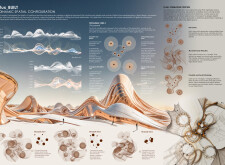5 key facts about this project
### Overview
Located in an urban environment, the project focuses on creating dynamic spatial configurations that respond adaptively to user interactions and ecological needs. The intent is to move beyond traditional architectural boundaries by integrating advanced digital technologies to foster environments that facilitate connectivity and functionality. The design framework encompasses three distinct zones: the Adaptive Hub, the Virtual Performance Zone, and the Ecological Simulation Lab, each carefully curated to enhance user experience through adaptable and interactive spatial arrangements.
### Spatial Configuration and User Interaction
The Adaptive Hub serves as a central node for communal engagement, promoting flexibility in layout to accommodate various functions based on user needs. It employs parametric design principles that reflect biological systems, facilitating efficient use of space while enhancing aesthetic appeal. The Virtual Performance Zone introduces an immersive environment responsive to user movements, integrating technology to create personalized experiences that emphasize interactivity and sensory engagement. This zone supports a range of activities from performances to exhibitions, adapting in real-time to the dynamics of its users.
### Material Selection and Sustainability
The project utilizes a carefully selected palette of materials to balance aesthetics and functionality. Prominent materials include glass for transparency, aluminum for structural integrity, and concrete for durability. Composite materials enable complex geometries that align with the fluid architectural style. Together, these materials not only contribute to an evocative dimensionality within the structure but also reflect a commitment to sustainable practices. The Ecological Simulation Lab exemplifies this focus on sustainability by employing adaptive control systems and real-time data integration, promoting innovative ecological solutions and responsive design methodologies. This zone acts as a research platform exploring the implications of ecological principles on contemporary architectural practices.



















































